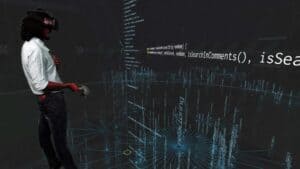Here’s a fascinating immersive experience that lets you visualize code in virtual reality. It’s a platform from Primitive, a startup that pitched at an HTC venture capital accelerator this week in San Francisco. According to the company,
. . . we believe that collaboration and immersive visualization are the future of software development. The arrival of virtual reality has provided a groundbreaking new platform to visualize data and collaborate in advanced ways.
In RoadtoVR, Ben Lang observes that,
Primitive represents one of the most interesting use-cases I’ve seen for VR so far—it creates 3D visualizations of source code that can be collaboratively explored and analyzed in VR. It’s creators believe that bringing a spatial understanding to otherwise flat code enhances the development process of complex code created by distributed development teams.
Watching the trailer may give you flashbacks from The Matrix. It will also make you feel like this is our future. Not only will the world be made of code, but we’ll also be able to step inside it.
RoadtoVR continues,
Using VR as a foundation for intuitive, immersive visualization, Primitive has developed plugins for popular code writing programs like Visual Studio and JetBrains tools which take source code, and with the click of a button, maps it into a 3D visualization which shows how the mass of coded is structured.
Visualizing Code in VR
Primitive addresses an increasing challenge in contemporary code development. Most large development teams no longer work in the same location. And with legacy code everywhere, it would help in on-boarding new team members. Grab a headset and see how a complex code base works.
Primitive founder John Voorhees framed his pitch around the idea that software is the foundation of the 21st century; companies across all industries rely on software to get work done, and much of that software is now created by distributed teams who may not work in the same building or even country. Much of the code base that underpins everything from banks to retail to infrastructure, and everything in between, is very large, often quite old, and only growing in complexity.
Using their plugins for popular IDEs, Primitive says that developers will see,
Architectural Overviews: up to several million lines of code
3D Call Graphs: spatial layouts that are clearer and more memorable
Multi-thread Runtime Animations: for debugging and performance evaluation
Visualization and Collaboration
Primitive’s platform brings together elements that make virtual reality so powerful – visualizing what can’t be seen and spanning geographical distance through virtual collaboration. It opens a new way of learning about code through spatial memory and collaboration. You could see this being used in learning environments. Visual learners might find programming not so intimidating if it’s rendered in 3D.
Multiple users can connect into the visualization with various VR headsets, and actually walk around and interact with the code base with other people standing in the same virtual space. The use of spatial audio and avatars allow users to discuss the code together.
Primitive is still in the early rounds of funding. But its developments like this that have the potential to revolutionize how we work and learn.
Yet, every time we look at it, we can’t help but think of those cascading green lines of code at the end of a long hallway. The ones that, as Neo watched, consumed the world he thought he knew.

Emory Craig is a writer, speaker, and consultant specializing in virtual reality (VR) and generative AI. With a rich background in art, new media, and higher education, he is a sought-after speaker at international conferences. Emory shares unique insights on innovation and collaborates with universities, nonprofits, businesses, and international organizations to develop transformative initiatives in XR, GenAI, and digital ethics. Passionate about harnessing the potential of cutting-edge technologies, he explores the ethical ramifications of blending the real with the virtual, sparking meaningful conversations about the future of human experience in an increasingly interconnected world.

